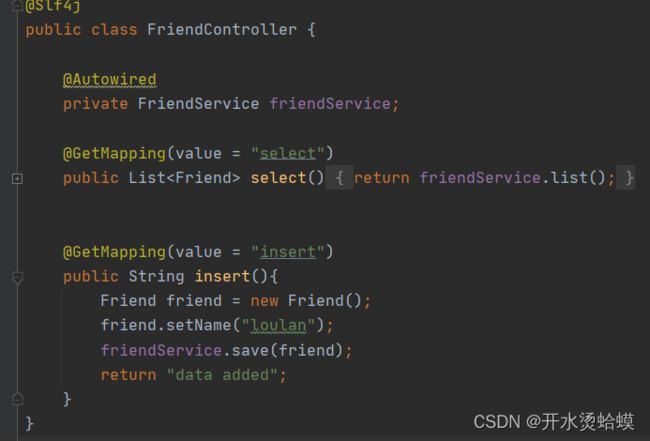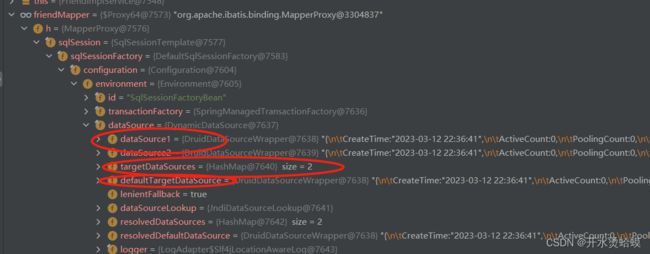数据源切换
目录
应用场景
疑问
将就吧
数据源管理方案
AbstractRoutingDataSource
使用MyBatis注册多个SqlSessionFactory
使用dynamic-datasource框架
应用场景
疑问
我感觉这个好像没啥应用场景啊,一个服务对应一个数据库不是挺好的嘛,你这个服务还可以访问其他的数据库资源,那不是乱套了嘛
将就吧
就这么用呗,借鉴一下这个思想
数据源管理方案
AbstractRoutingDataSource
使用Spring提供的AbstractRoutingDataSource,这种方式的核心是使用Spring提供的AbstractRoutingDataSource抽象类,注入多个数据源
@Component
@Primary // 将该Bean设置为主要注入Bean
public class DynamicDataSource extends AbstractRoutingDataSource {
// 当前使用的数据源标识
public static ThreadLocal name=new ThreadLocal<>();
// 写
@Autowired
DataSource dataSource1;
// 读
@Autowired
DataSource dataSource2;
// 返回当前数据源标识
@Override
protected Object determineCurrentLookupKey() {
return name.get();
}
@Override
public void afterPropertiesSet() {
// 为targetDataSources初始化所有数据源
Map targetDataSources=new HashMap<>();
targetDataSources.put("W",dataSource1);
targetDataSources.put("R",dataSource2);
super.setTargetDataSources(targetDataSources);
// 为defaultTargetDataSource 设置默认的数据源
super.setDefaultTargetDataSource(dataSource1);
super.afterPropertiesSet();
}
}
将自己实现的DynamicDataSource注册成为默认的DataSource实例后,只需要在每次使用 DataSource时,提前改变一下其中的name标识,就可以快速切换数据源。
@Component
@Aspect
public class DynamicDataSourceAspect implements Ordered {
// 前置
// 在每个访问数据库的方法执行前执行。
@Before("within(com.tuling.dynamic.datasource.service.impl.*) && @annotation(wr)")
public void before(JoinPoint point, WR wr){
String name = wr.value();
DynamicDataSource.name.set(name);
System.out.println(name);
}
@Override
public int getOrder() {
return 0;
}
// 环绕通知
}处理流程
1. 首先是通过接口进行访问,准备读数据库
2. 然后到了前置aop进行功能增强
这里就顺便看一下入参都是啥东西,point我感觉就是代理的方法,这边这代理是cglib代理,而下面那个注解用的代理则是动态代理
这里面就是通过你注解里面设的值放到DynamicDataSource.name里面去
然后幸亏之前看了点mybatis源码,datasource设置的清清楚楚
两个数据源,每个数据源里面已经定义好了连接地址等配置信息,还有我们之前配置的targetDatasource和defaultTargetDataSource
我们顺便再来看一下,mybatis底层这个数据源是啥选择的,是吧都已经看到这里了,就再往下看看呗
public class DynamicDataSource extends AbstractRoutingDataSource还是得从这里看起,因为我们选择的是路由数据源的方式,因为我们继承了abstractRoutingDataSource,我们选择重写这两个方法,一个是选择路由到哪个数据源,一个是看名字我猜是,在所有配置信息完成后的操作,我们这里面配置了目标数据源map的定义,然后是默认数据源,以及再走父类的afterProperties方法
// 返回当前数据源标识
@Override
protected Object determineCurrentLookupKey() {
return name.get();
}
@Override
public void afterPropertiesSet() {
// 为targetDataSources初始化所有数据源
Map targetDataSources=new HashMap<>();
targetDataSources.put("W",dataSource1);
targetDataSources.put("R",dataSource2);
super.setTargetDataSources(targetDataSources);
// 为defaultTargetDataSource 设置默认的数据源
super.setDefaultTargetDataSource(dataSource1);
super.afterPropertiesSet();
} 这里还看不出来那个lookupkey是干嘛用的,继续往下看,走到父类的方法中
public void afterPropertiesSet() {
if (this.targetDataSources == null) {
throw new IllegalArgumentException("Property 'targetDataSources' is required");
} else {
this.resolvedDataSources = CollectionUtils.newHashMap(this.targetDataSources.size());
this.targetDataSources.forEach((key, value) -> {
Object lookupKey = this.resolveSpecifiedLookupKey(key);
DataSource dataSource = this.resolveSpecifiedDataSource(value);
this.resolvedDataSources.put(lookupKey, dataSource);
});
if (this.defaultTargetDataSource != null) {
this.resolvedDefaultDataSource = this.resolveSpecifiedDataSource(this.defaultTargetDataSource);
}
}
}这里面代码也很好懂,定义最后要用的数据源的map和默认最后用哪个数据源的map,我自己理解的
看到这里我就去找怎么确认最后使用哪个数据源,发现有这么个方法,我猜这个是决定使用哪个数据源,看看下面就是通过这个lookupkey找数据源
protected DataSource determineTargetDataSource() {
Assert.notNull(this.resolvedDataSources, "DataSource router not initialized");
Object lookupKey = this.determineCurrentLookupKey();
DataSource dataSource = (DataSource)this.resolvedDataSources.get(lookupKey);
if (dataSource == null && (this.lenientFallback || lookupKey == null)) {
dataSource = this.resolvedDefaultDataSource;
}
if (dataSource == null) {
throw new IllegalStateException("Cannot determine target DataSource for lookup key [" + lookupKey + "]");
} else {
return dataSource;
}
}Object lookupKey = this.determineCurrentLookupKey();// 我们看到有这么一句话
我们来看看这个设置的是个啥,接着找实现类
@Nullable
protected abstract Object determineCurrentLookupKey();哦豁,正好是我们重写的方法,那就直接进去呗,就是我们之前定义的w,r
@Override
protected Object determineCurrentLookupKey() {
return name.get();
}我们这里面还是这么定义的,通过threadLocal,每个线程有这么一份变量
public static ThreadLocal name=new ThreadLocal<>(); 我们通过这么一设置,到时候通过以上的步骤,等到使用mybatis操作数据库的时候,就知道最终使用的是哪个数据源了
使用MyBatis注册多个SqlSessionFactory
看一下配置类定义的
@Configuration
// 继承mybatis:
// 1. 指定扫描的mapper接口包(主库)
// 2. 指定使用sqlSessionFactory是哪个(主库)
@MapperScan(basePackages = "com.tuling.datasource.dynamic.mybatis.mapper.r",
sqlSessionFactoryRef="rSqlSessionFactory")
public class RMyBatisConfig {
@Bean
@ConfigurationProperties(prefix = "spring.datasource.datasource2")
public DataSource dataSource2() {
// 底层会自动拿到spring.datasource中的配置, 创建一个DruidDataSource
return DruidDataSourceBuilder.create().build();
}
@Bean
@Primary
public SqlSessionFactory rSqlSessionFactory()
throws Exception {
final SqlSessionFactoryBean sessionFactory = new SqlSessionFactoryBean();
// 指定主库
sessionFactory.setDataSource(dataSource2());
// 指定主库对应的mapper.xml文件
/*sessionFactory.setMapperLocations(new PathMatchingResourcePatternResolver()
.getResources("classpath:mapper/r/*.xml"));*/
return sessionFactory.getObject();
}
@Bean
public DataSourceTransactionManager rTransactionManager(){
DataSourceTransactionManager dataSourceTransactionManager = new DataSourceTransactionManager();
dataSourceTransactionManager.setDataSource(dataSource2());
return dataSourceTransactionManager;
}
@Bean
public TransactionTemplate rTransactionTemplate(){
return new TransactionTemplate(rTransactionManager());
}
}没搞明白他这个事务管理器和模板干啥用的
配置完事好像直接就能使用了
使用dynamic-datasource框架
dynamic-datasource是MyBaits-plus作者设计的一个多数据源开源方案。使用这个框架需要引入对应的pom依赖
com.baomidou
dynamic-datasource-spring-boot-starter
3.5.0
这样就可以在SpringBoot的配置文件中直接配置多个数据源。
spring:
datasource:
dynamic:
#设置默认的数据源或者数据源组,默认值即为master
primary: master
#严格匹配数据源,默认false. true未匹配到指定数据源时抛异常,false使用默认数据源
strict: false
datasource:
master:
url: jdbc:mysql://127.0.0.1:3306/datasource1?serverTimezone=UTC&useUnicode=true&characterEncoding=UTF8&useSSL=false
username: root
password: root
initial-size: 1
min-idle: 1
max-active: 20
test-on-borrow: true
driver-class-name: com.mysql.cj.jdbc.Driver
slave_1:
url: jdbc:mysql://127.0.0.1:3306/datasource2?serverTimezone=UTC&useUnicode=true&characterEncoding=UTF8&useSSL=false
username: root
password: root
initial-size: 1
min-idle: 1
max-active: 20
test-on-borrow: true
driver-class-name: com.mysql.cj.jdbc.Driver这样就配置完成了master和slave_1两个数据库。
接下来在使用时,只要在对应的方法或者类上添加@DS注解即可。例如
@Service
public class FriendImplService implements FriendService {
@Autowired
FriendMapper friendMapper;
@Override
@DS("slave_1") // 从库, 如果按照下划线命名方式配置多个 , 可以指定前缀即可(组名)
public List list() {
return friendMapper.list();
}
@Override
@DS("master")
public void save(Friend friend) {
friendMapper.save(friend);
}
// @DS("master")
// @DSTransactional
// public void saveAll(){
// // 执行多数据源的操作
// }
} 





